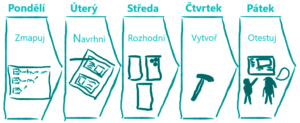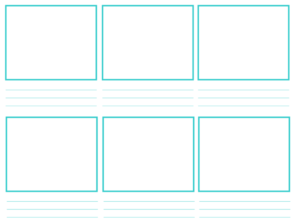To find answers, let's take a look at Google Ventures Design Sprint (DS) — a five-day process to answer questions critical to your business through design, prototyping and design testing with your customers.
The magic of DS lies in the targeting of individual stages (days) to specific objectives, which together lead to the desired result. In short, each stage can be imagined as follows:
- Mondays — mapping and understanding the problem and defining the goal
- At the same time, the formation of a team converges, people who did not have to meet before and who will cooperate intensively in the upcoming team
- Tuesdays — creation of proposals
- It's difficult to step out of the bubble and look for inspiration around primal principles and ideas out there somewhere
- Wednesday Deciding what and how to prototype
- Includes challenging activities from the perspective of the team involved — especially storyboard preparation
- Thursday — Prototype preparation
- Concentration can slowly decline, as the designer typically takes the reins and the rest of the team may be fumbling over what to do
- Friday — testing the prototype with the customer
- More eyes see more — the whole team watches the converging interviews and everyone catches their eye

Everything stands and falls on the involvement of people in DS - the prerequisite is full time involvement, i.e. focus on DS for the whole week. Such a setting supports team dynamics and greatly facilitates communication and collaboration. The successful course of DS is further supported by the availability of a number of exercises and techniques that contribute to the understanding and mastery of the individual stages. The techniques do not only bind to the DS as such and can be used alone. For example, these are:
- HMW (How Might We) Questions
- You rephrase a problem into an opportunity
- For example, you rephrase the statement “Non-technical users cannot create a website on their own.” to “How can we simplify the creation of a website for non-technical users?”
- Map
- Simple 5-15 step diagram describing roles and parts into a diagram
- Lightning demo
- These are short demos of already existing inspirational ideas that are part of existing solutions and serve as inspiration for the design
- Crazy 8s
- 8 minutes to think about alternative routes
- 8 minutes to think about alternative routes

- Storyboard
- Step by step plan from the perspective of the solved use case
- Step by step plan from the perspective of the solved use case

Surely you will come across a lot of interesting situations and take away new experiences. What else have I learned during my time at DS?
- Start slowly and thoroughly so that you are able to go fast and not get stuck.
- Do not underestimate the need for synchronization during prototyping.
- Whoever makes the decisions should be with the team at all times.
- The rules agreed at the beginning will create a relaxing atmosphere throughout the week.
- DS is an ideal way to converge roles (insight into the workings of others, sharing thought marches with each other).
When is the Sprint Design fit to be used?
- It's about a lot
- Imagine a situation where you are faced with a big problem and the solution requires a lot of time and finances. It's the same as being the captain of a ship — DS is your chance to check the navigation and then head full steam ahead.
- You have limited time
- The deadline is approaching. You need good solutions, fast. As the DS name suggests, a targeted sprint may be the right choice.
- You're just stuck
- The beginnings of some important projects are hard. Some become stunted after a while, and there is trampling on the spot. In such cases, the DS can be the right drive, a fresh approach to solving the problem.
When, on the other hand, would you rather not consider Sprint Design, even if it may be tempting at first glance?
You have a clear idea of the solution to the problem that you plan to implement. In this case, as a result, you will receive with a high probability confirmation of your original solution (confirmation bias).
And remember that”You can't lose in a sprint, you have a unique opportunity to learn from your customers“.
Are you interested in Sprint Design and would you like to try it at your place? Do not hesitate to contact me, I will be happy to guide you through it.

